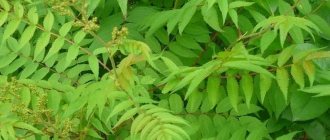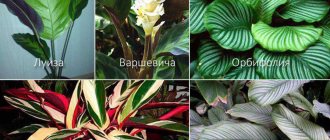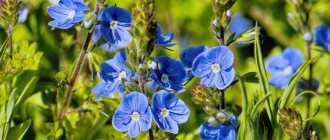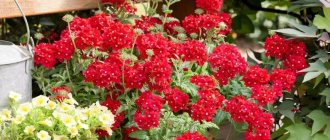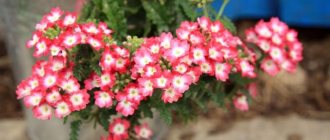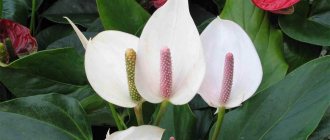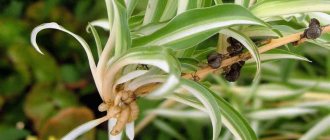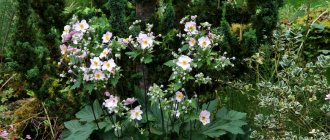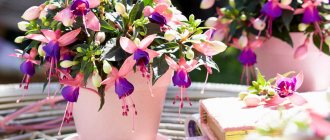Verbena is a very popular plant; there are incredibly many varieties of it.
In cold climates it is grown as an annual, and in regions with mild winters, verbena is cultivated as a perennial plant.
Ampelous verbena with beautiful flowing shoots is very popular among gardeners.
Botanical characteristics and history of appearance
The ampelous form is annual. This is a herbaceous plant that belongs to the family of the same name.
It is distinguished by its ability to bloom abundantly; more than 30 buds can bloom simultaneously on one stem . The flowers are small, with 5 petals, collected in umbrella inflorescences.
Interesting! Thanks to the work of breeders, flowers with heterogeneous color (with a white flower core) are found.
The homeland of verbena is America. It was from these two continents that verbena came to Europe, where it took root and spread further around the world.
Verbena: what is it?
Verbena belongs to the verbena family and has about 250 varieties of seasonal and perennial plants. It grows well in any climate zone; in tropical conditions it blooms profusely almost all year round and looks like a small shrub. That is, by its very nature, verbena is perennial. But in our country it is most often grown as a herbaceous annual.
Plant height varies from 20-40 cm (hybrid and Canadian verbena) to 150-200 cm (Bonar verbena, hard, lemon). The width of even low-growing varieties often reaches 70–80 cm. Depending on the type of flower, the stems can be erect (bush varieties) or creeping (ampels).
Bonar or Buenos Aires verbena (Verbena bonariensis) is a tall plant that blooms with purple fragrant flowers.
Hybrid verbena (Verbena hybrida) is the most common species, distinguished by a variety of varieties. Pictured is the Vegas Fluor Pink variety
The jagged leaves of verbena have a pretty bright green hue. On each individual stem of the plant, 40–50 miniature carnation-like flowers are formed, which create a beautiful “cap”.
The color palette of inflorescences is very diverse. White, pink, peach, red, violet, blue, blue - these are not all the tones that verbena can boast of. Moreover, the flowers can be either monochromatic or combine several colors at once. For example, the hybrid verbena variety Lanai Twister Red has inflorescences with scarlet and pink petals. And the Tuscany Burgundy Eye variety is distinguished by dark burgundy colors with a white eye in the center.
Hybrid verbena Lanai Twister Red
Description and photos of varieties
There are approximately 250 varieties . The most popular and widespread are the following.
Imagination
Long shoots are crowned with purple spherical inflorescences.
The bush quickly gains green mass and begins to bloom. Flowering is abundant and long lasting.
Attention! This verbena is used not only for landscaping terraces and balconies, but also as a ground-covering plant, since it quickly weaves the surface of a flower bed.
Lanai candy cane
A beautiful plant with shoots up to half a meter and bright red flowers.
The core of the flower has a crimson hue and stands out against the background of a white star-shaped spot.
Moon River
The variety has high decorative qualities. Its long vines are decorated with oblong leaves and lavender flowers.
Peach and cream
A distinctive feature of this variety was its unusual color, for which the plant was awarded the Flerselect medal in 1992.
The flowers combine pink, cream and apricot tones.
Mammut
An old variety, cultivated for a long time. The plant is remarkable for its elongated inflorescences and fairly long stems.
Tropic
The variety is distinguished by the beautiful even red color of its buds.
Temari (temari)
This variety is highly resistant to fungal infections.
The branched shoots are decorated with purple and purple flowers.
Tapien (tapien)
A bush with creeping shoots is literally dotted with small two-color buds.
It has a long flowering period and is easy to care for.
The Snow Queen
Plants of this variety have five different colors.
Empress peach
Compact shoots up to half a meter long are densely covered with a cap of creamy peach flowers.
Amethyst
A bush with long flowering and very beautiful white and purple flowers.
Quartz XP silver
The shoots of this variety are short (no more than 30 cm), strewn with white flowers with a silvery tint.
Features of the view
The peculiarity of this plant is that it is an excellent food for butterflies and caterpillars. In addition, the flowers are famous for their medicinal properties. They can be used to treat abscesses and scrofula. The plant also increases brain activity. Read more about the beneficial properties, use and contraindications here. Of course, the direct purpose of ampelous verbena is decorative. It is installed on a windowsill or planted in a flower bed.
Reference! It differs from other species in the size of its flowers, as well as its neat foliage. In total, there are about 250 species of this crop, but the most commonly used is the Imagination ampel verbena, which is suitable for balcony and indoor cultivation.
Popular varieties with red and scarlet flowering
The most popular varieties have red flowers.
Tiara red impr (tiara red impr, or red imperial crown)
Bright red inflorescences look advantageous against the background of dark green foliage.
The bush is compact, unpretentious, and can withstand short frosts.
Estrella voodoo star
Flowers with two-tone colors - white and bright red.
Obsession Burgundy
Or an obsessive cascade. Refers to new varieties of verbena with high resistance to common diseases (for example, powdery mildew) and decorative qualities.
LiveInternetLiveInternet
–Tags
–Categories
- Library (40)
- Audiobooks (38)
- E-books (3)
- Videos (84)
- Cartoons (29)
- Opera (3)
- Miscellaneous (1)
- Theater (3)
- Movies (46)
- Humor (2)
- Knitting (4042)
- Openwork knitting (746)
- Mittens, gloves (10)
- video lessons (155)
- Knitting for children (432)
- Knitting from plastic bags (31)
- Crochet (2515)
- Knitting (1523)
- For home (143)
- For men (77)
- Irish lace (83)
- Books, magazines (185)
- suits (38)
- Dolls, toys (77)
- swimwear (3)
- Summer hats, panama hats (82)
- Master class (123)
- Socks, slippers (93)
- Dresses, sundresses (250)
- Blankets, rugs (155)
- Useful programs, links (8)
- Pullovers, jackets, vests (822)
- Romanian lace (1)
- Napkins, tablecloths, edge binding (172)
- Knitting Tips (56)
- Bags (167)
- Tops, blouses, tunics (810)
- Tunisian knitting (16)
- Patterns, motifs (462)
- Jewelry, rubber bands (4)
- Crochet Lessons (3)
- Sirloin knitting (55)
- Flowers, leaves (99)
- Hats, berets (279)
- Scarves, shawls, stoles (220)
- Skirts (70)
- Home perfumes (15)
- DIY perfume (12)
- Health, beauty (229)
- Videos (15)
- Gymnastics (51)
- Unconventional advice, folk remedies, magic (118)
- Healing music sessions (4)
- Tibetan medicine (9)
- Language learning (2)
- Karaoke (1)
- Houseplants (100)
- Growing, care (91)
- Useful properties (3)
- Cooking (1936)
- No bake (21)
- Pancakes, pancakes, pancakes (42)
- Lavash dishes (45)
- Jam (11)
- Video recipes (32)
- Main courses (183)
- Baking (670)
- Cooking in a jar (7)
- Cooking in a pot (6)
- Cooking in the microwave (21)
- Cooking in a slow cooker (59)
- Cooking in foil (2)
- Cooking in a bread machine (18)
- Desserts (150)
- Preparations, pickles (152)
- Snacks (131)
- Casseroles (61)
- For Easter (20)
- Porridge (12)
- Books, magazines (12)
- Ice cream (38)
- Drinks (73)
- Vegetables, mushrooms (134)
- Cookies, gingerbread, cupcakes (82)
- Pies, pies (355)
- Pizza (22)
- Lenten recipes (12)
- Fish, seafood (69)
- Salads (172)
- Sauces, spices (45)
- Spaghetti (4)
- Soups (51)
- Cheese, cottage cheese (32)
- Cakes, pastries (114)
- Bread, buns (109)
- Master class (52)
- Music (122)
- Unknown (3)
- Vegetable garden (9)
- Diary design (41)
- Decor (2)
- Buttons, comments (19)
- Frames (4)
- Emoticons (3)
- Blogging Tips (7)
- Schemes (1)
- Backgrounds (3)
- Watch (5)
- Congratulations (6)
- Useful tips (158)
- Orthodoxy (8)
- Programs (4)
- Handicrafts (94)
- Beading (8)
- For comfort in the home (2)
- Making flowers from fabric (3)
- Macrame (4)
- New Year (9)
- Origami (9)
- Newspaper weaving (24)
- Weaving from plastic bags (1)
- Miscellaneous (17)
- Tips for losing weight (68)
- Gymnastics (23)
- Diets (12)
- Drinks (17)
- Recipes (10)
- flash (3)
- Adventure games (2)
- Flowers (1)
- Photoshop (1)
- We sew ourselves (61)
- Esoterics (10)
- Humor (8)
Planting and growing from seeds at home
In annual growing conditions, it makes sense to plant bushes as seedlings, that is, sow seeds and grow seedlings in advance in order to transfer verbena to a flowerpot or flowerbed in the spring.
Growing seedlings
The optimal time for sowing seeds is early to mid-spring.
Important! You should not delay sowing seeds, otherwise the seedlings will not have time to gain leaf mass and flowering will be delayed or will not occur at all.
Therefore, if the planting date has been missed, it is more advisable to purchase ready-made seedlings.
For sowing, you can purchase universal soil for seedlings . It should be nutritious, loose, with high drainage capacity.
It is recommended to warm the seeds before planting. In this case, they can be placed in a damp cloth and left on the battery overnight.
There is no need to bury the seeds in the soil; just sprinkle them with a little substrate. Place the container in a warm, well-lit place and moisten it with a spray bottle.
Shoots should appear on days 5–7. If this does not happen, shock therapy is used. The pot with the crops is placed on the radiator for about 2–3 hours, and then in the refrigerator overnight. After this treatment, the seedlings hatch already on the 3rd day .
When to plant in the ground
It is recommended to plant seedlings in the ground no earlier than mid-May , when the threat of return frosts has passed. Before transplanting into open ground, seedlings need to be hardened off for 2 weeks, taking them out onto a balcony or terrace for several hours.
Application in landscape design
Thanks to its lush flowering and variety of colors, ampelous verbena fits well into any garden. It is used in different ways:
- in unusual pots to decorate the recreation area;
- ground cover plantings perfectly hide the soil;
- in flower pots on gazebos and fences;
- in mixborders and discounts;
- in outdoor containers near the entrance, along garden paths.
Attention! To use ampel verbena as a ground cover plant, its branches can be pinned to the ground and sprinkled with soil to obtain layering.
Seedlings can be planted both in the ground and on a small hill
Planting and care photo
Verbena is light-loving, so they choose an open, sunny place for it.
Lighting, air, temperature
Do not move pots of verbena into the shade: it must receive enough ultraviolet light to bloom profusely. In addition, it is better to choose a place where there are no drafts, but the bush is forgiving to temperature conditions .
Important! Most varieties tolerate short-term drops in temperature well.
The soil
It is advisable to select light, loose soils, but in general, verbena is not capricious and undemanding to the quality of the soil.
Watering
Watering should be done moderately but regularly. Optimal watering regime: do not allow the top layer of soil to dry out , but do not allow moisture to stagnate.
Feeding
Fertilizers are applied throughout the growing season . They begin fertilizing with nitrogen complexes, and from the moment of transplanting into open ground, nitrogen is replaced with potassium-phosphorus fertilizers.
Vervain's temperament
Verbena is quite unpretentious. It is resistant to heat and drought. It is not afraid of slight autumn and spring frosts (down to -3°C), so it can delight with its flowering from spring to October (in midday regions - even longer).
Also, verbena does not make any special demands on the quality of the soil. The only condition: it must allow moisture to pass through well and prevent stagnation of water and subsequent waterlogging. Clayey, heavy soil is not suitable; it slows down root growth and causes root rot. In midday regions, perennial varieties of verbena often disappear when planted in soil that becomes damp after heavy winter snow or spring rain. Good drainage can compensate for this problem.
Another perfection of verbena is its long flowering, which does not subside in the summer heat. And a very wide range of colors.
Reproduction
Verbena is propagated by cuttings and by growing from seeds.
Cuttings of ampelous verbena
A bush that was harvested for the winter is subjected to cuttings. In February–March it is removed from the basement and cuttings are prepared.
For this:
- the apical part of the shoots is cut off (at least 5 leaves);
- maintain a distance of at least 1 cm between the lower leaf and the place where the cutting is cut off;
- the lower 2 leaves are removed, the cut is treated with “Kornevin”;
- the cuttings are planted in a loose sand-peat mixture up to the lower pair of cut leaves;
- It is recommended to cover the cuttings with a jar to form a greenhouse;
- Watering is carried out as the top layer of soil dries;
- The jar is removed daily for 10–20 minutes for ventilation.
The cuttings take root in 4–5 weeks.
Collecting and planting seeds
Verbena seeds have good germination rates, so many gardeners collect them after flowering . Store the seeds in a paper bag at room temperature and plant them in March–April to grow seedlings.
What plants does it go with?
Ampelous verbena is valued for its variety of varieties and external characteristics, and ease of care. This is an unpretentious plant that can be combined with other crops. Falling shoots are used to create hanging compositions and vertical gardening.
Verbena can be planted as a ground cover in flower beds and rock gardens. The flower is placed under trees and bushes, along paths. When planted, the plant is combined with the following crops:
- petunias;
- camellias;
- asters;
- marigold.
Important! It is advisable to place the bushes tightly for maximum decorative effect.
Pests and diseases
Verbena rarely gets sick, since this plant is resistant to most diseases. However, if watering is improper, root rot can develop . Timely replanting and revision of the watering regime can save the plant.
Among the pests, aphids parasitize verbena . If a parasite is detected, the plant is treated with insecticides.
